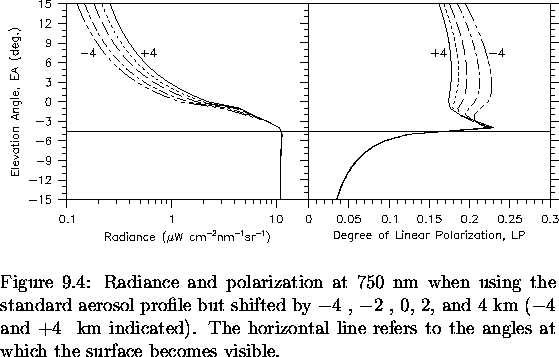
Next, the effects of shifting the entire profile up and down are examined.
Results for shifts of ![]() and
and ![]() km are shown in Figure 5.5.
The effects of shifting the aerosol layer is to be seen to be similar to
that of scaling the aerosol profile. Shifting it up acted to increase
radiance and decrease polarization as the maximum in the profile was
moved closer to 20 km. Differences in radiance between successive
curves were consistently found to be 10-20% for uplooking angles.
For downlooking angles this difference dropped rapidly to near zero.
Polarization differences between successive curves were found to vary
from 0.01 to 0.03.
km are shown in Figure 5.5.
The effects of shifting the aerosol layer is to be seen to be similar to
that of scaling the aerosol profile. Shifting it up acted to increase
radiance and decrease polarization as the maximum in the profile was
moved closer to 20 km. Differences in radiance between successive
curves were consistently found to be 10-20% for uplooking angles.
For downlooking angles this difference dropped rapidly to near zero.
Polarization differences between successive curves were found to vary
from 0.01 to 0.03.
One important point to note is that the -4 km shifted profile produced uplooking radiance nearly identical to the 0.6 scaled uplooking radiance from Figure 5.4. It turns out that these altered profiles are very nearly the same above 20 km (but quite different below). Hence, for uplooking angles, only the profile above the height of the observations is important. Similarly, for downlooking angles which do not intercept the surface, only the profile above the tangent height is important. Similar conclusions were drawn from the previous study (McLinden et al., 1998).